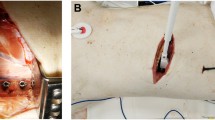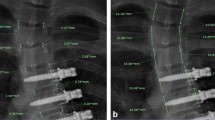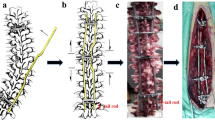Abstract
Study design
Experimental biomechanical study of pressures exerted on the epiphyseal growth plates (GP) in tethered porcine cadaveric spines.
Objectives
To experimentally measure the pressure exerted on the vertebral end plates of a tethered porcine spine model.
Summary of background data
Flexible spine tethering is a novel fusionless surgical technique that aims to correct scoliotic deformities based on growth modulation due to the pressure exerted on vertebral body epiphyseal GP. The applied pressure resulting from spine tethering remains not well documented.
Methods
The ligamentous thoracic segment (T1–T14) of four 3-months old Duroc Landrace pigs (female; 22 kg, range: 18–27 kg) was positioned in lateral decubitus in a custom-made stand. Vertebra T14 was clamped but the remaining spine was free to slide horizontally. For every specimen, six configurations were tested: three or five instrumented motion segments (T5–T10 or T7–T10) with applied compression of 22, 44 or 66 N. The pressure generated on the GPs in the tethered side was measured with a thin force sensor slid either at the proximal, apex or distal levels. The data were analyzed with an ANOVA.
Results
The pressure was significantly different between three and five instrumented motion segments (averages of 0.76 MPa ± 0.03 and 0.60 MPa ± 0.03, respectively; p < 0.05), but the pressure exerted on each GP along the instrumented spine was not significantly different for a given number of instrumented levels. The pressure was linearly correlated to the tether tension.
Conclusions
Non segmental anterior spine tethering induced similar pressures on every instrumented level regardless of the number of instrumented levels, with 21% lesser pressures with 5 motion segments.
Level of evidence
Level IV.



Similar content being viewed by others
References
Tambe AD, Panikkar SJ, Millner PA, Tsirikos AI (2018) Current concepts in the surgical management of adolescent idiopathic scoliosis. Bone Jt J 100-B(4):415–424
Schlager B, Ismael Aguirre M-F, Wilke H-J, Galbusera F (2018) Scoliosis. Elsevier, Amsterdam
Djurasovic M, Glassman SD, Sucato DJ, Lenke LG, Crawford CH, Carreon LY (2016) Improvement in SRS22R pain scores after surgery for adolescent idiopathic scoliosis. Spine (Phila. Pa. 1976) 43(2):127–132
Goldberg CJ, Moore DP, Fogarty EE, Dowling FE (2007) Scoliosis: a review. Pediatr Surg Int 24(2):129–144
Dimeglio A, Canavese F, Charles YP (2011) Growth and adolescent idiopathic scoliosis: when and how much? J Pediatr Orthop 31(1):28–36
Murphy RF, Mooney JF (2017) The crankshaft phenomenon. J Am Acad Orthop Surg 25(9):e185–e193
Skaggs DL, Akbarnia BA, Flynn JM, Myung KS, Sponseller PD, Vitale MG (2013) A classification of growth friendly spine implants. J Pediatr Orthop 34(3):260–274
Driscoll M, Aubin C-E, Moreau A, Parent S (2011) Biomechanical comparison of fusionless growth modulation corrective techniques in pediatric scoliosis. Med Biol Eng Comput 49(12):1437–1445
Ames RJ, Samdani AF, Betz RR (2016) Anterior scoliosis correction in immature patients with idiopathic scoliosis. Oper Tech Orthop 26(4):247–257
Pahys JM et al (2015) The first 100 consecutive anterior vertebral body tethering procedures for immature adolescent idiopathic scoliosis at a single institution: outcomes and complications in the early postoperative period. In: International meeting on advanced spine techniques, pp 200–201
Meir AR, Fairbank JCT, Jones DA, McNally DS, Urban JPG (2007) “High pressures and asymmetrical stresses in the scoliotic disc in the absence of muscle loading. Scoliosis 2:4
Stokes IA, Spence H, Aronsson DD, Kilmer N (1996) Mechanical modulation of vertebral body growth: implications for scoliosis progression. Spine (Phila. Pa. 1976) 21(10):1162–1167
Cobetto N, Aubin CE, Parent S (2018) Surgical planning and follow-up of anterior vertebral body growth modulation in pediatric idiopathic scoliosis using a patient-specific finite element model integrating growth modulation. Spine Deform 6(4):344–350
Aubin C, Parent S, Villemure I, Amini S, Driscoll M, Moldovan F (2014) Dynamic fusionless device for the correction of adolescent idiopathic scoliosis. WO2014127464 A1
Ménard A-L, Grimard G, Valteau B, Londono I, Moldovan F, Villemure I (2014) In vivo dynamic loading reduces bone growth without histomorphometric changes of the growth plate. J Orthop Res 32(9):1129–1136
Bazergui A, Biron A, Bui-Quoc T, Laberge C, McIntyre G (2002) Résistance des matériaux, 3rd edn. Presses internationales de Polytechnique. ISBN 9782553010347
Villemure I, Stokes IAF (2009) Growth plate mechanics and mechanobiology. A survey of present understanding. J Biomech 42(12):1793–1803
Courvoisier A, Eid A, Bourgeois E, Griffet J (2015) Growth tethering devices for idiopathic scoliosis. Expert Rev Med Devices 12(October):449–456
Chay E et al (2012) Impact of unilateral corrective tethering on the histology of the growth plate in an established porcine model for thoracic scoliosis. Spine (Phila. Pa. 1976) 37(15):E883–E889
Cobetto N, Parent S, Aubin CE (2018) 3D correction over 2 years with anterior vertebral body growth modulation: a finite element analysis of screw positioning, cable tensioning and postoperative functional activities. Clin Biomech 51(November 2017):26–33
Aubin CÉ, Clin J, Rawlinson J (2018) Biomechanical simulations of costo-vertebral and anterior vertebral body tethers for the fusionless treatment of pediatric scoliosis. J Orthop Res 36(1):254–264
Hachem B, Aubin CE, Parent S (2017) Porcine spine finite element model: a complementary tool to experimental scoliosis fusionless instrumentation. Eur Spine J 26(6):1610–1617
Newton PO et al (2008) Spinal growth modulation with use of a tether in an immature porcine model. J Bone Jt Surg Am 90(12):2695–2706
Schmidt H, Heuer F, Wilke H (2008) Interaction between finite helical axes and facet joint forces under combined loading. Spine (Phila. Pa. 1976) 33(25):2741–2748
Ekström L, Holm S, Holm AK, Hansson T (2004) In vivo porcine intradiscal pressure as a function of external loading. J Spinal Disord Tech 17(4):312–316
Cobetto N, Aubin CE, Parent S (2018) Contribution of lateral decubitus positioning and cable tensioning on immediate correction in anterior vertebral body growth modulation. Spine Deform 6(5):507–513
Busscher I, Ploegmakers JJW, Verkerke GJ, Veldhuizen AG (2010) Comparative anatomical dimensions of the complete human and porcine spine. Eur Spine J 19(7):1104–1114
Smit TH (2002) The use of a quadruped as an in vivo model for the study of the spine: biomechanical considerations. Eur Spine J 11(2):137–144
Moal B et al (2013) The impact of a corrective tether on a scoliosis porcine model: a detailed 3D analysis with a 20 weeks follow-up. Eur Spine J 22(8):1800–1809
Roth AK, Bogie R, Jacobs E, Arts JJ, van Rhijn LW (2013) “Large animal models in fusionless scoliosis correction research: a literature review. Spine J 13(6):675–688
Schwab F, Patel A, Lafage V, Farcy J-P (2009) “A porcine model for progressive thoracic scoliosis. Spine (Phila. Pa. 1976) 34(11):E397–E404
Ouellet J, Odent T (2013) Animal models for scoliosis research: state of the art, current concepts and future perspective applications. Eur Spine J 22(Suppl 2):S81–S95
Acknowledgements
The author wish to acknowledge the help of Leonardo Ruiz for his participation during the experiments as well as the Natural Sciences and Engineering Research Council of Canada and Medtronic of Canada (industrial research chair program).
Funding
Pr Aubin’s Natural Sciences and Engineering Research Council of Canada (NSERC)/Medtronic industrial research Chair.
Author information
Authors and Affiliations
Contributions
VL, IV, SP, C-EA: Substantial contributions to the conception or design of the work; or the acquisition, analysis, or interpretation of data for the work. VL, IV, SP, C-EA: Drafting the work or revising it critically for important intellectual content. VL, IV, SP, C-EA: Final approval of the version to be published.
Corresponding author
Ethics declarations
IRB
Cadaveric specimen from slaughterhouses, no IRB needed.
Additional information
Publisher’s Note
Springer Nature remains neutral with regard to jurisdictional claims in published maps and institutional affiliations.
Rights and permissions
About this article
Cite this article
Lalande, V., Villemure, I., Parent, S. et al. Induced pressures on the epiphyseal growth plate with non segmental anterior spine tethering. Spine Deform 8, 585–589 (2020). https://doi.org/10.1007/s43390-020-00070-z
Received:
Accepted:
Published:
Issue Date:
DOI: https://doi.org/10.1007/s43390-020-00070-z




